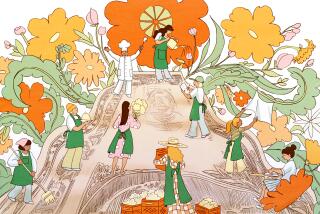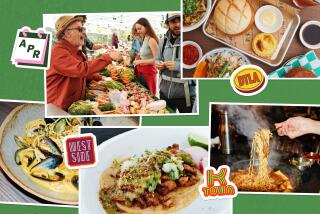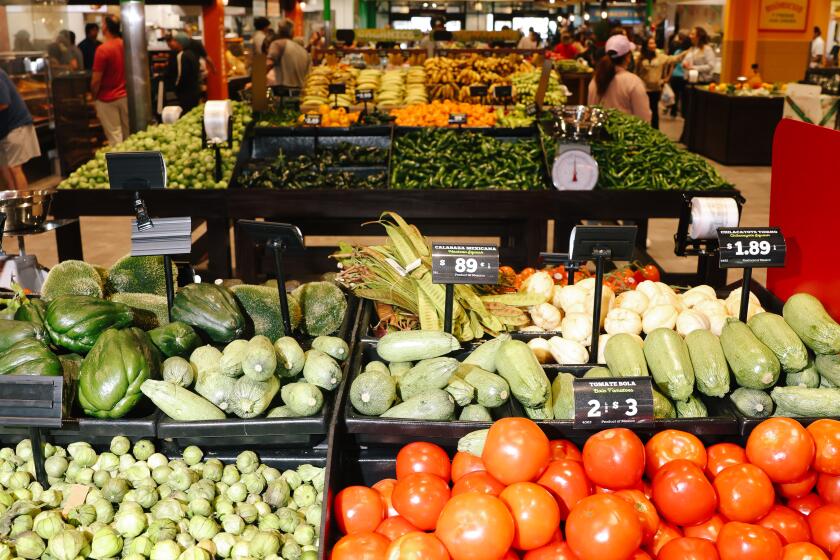MARKETS : Eastern Europe Meets West Hollywood
Royal Gourmet Russian Deli, 8151 Santa Monica Blvd., West Hollywood, (213) 650-5001. Open 9 a.m. to 9 p.m. daily.
The open cooler at Royal Gourmet Deli is something to behold. It’s filled with willow baskets appetizingly heaped with jars of caviar, slabs of smoked fish, tins of French goose fat, salami, cheese and imported condiments, all seemingly arranged for some royal picnic Tolstoy might have described.
A mirrored wall behind the deli cases reflects shimmery, foil-wrapped confections arranged around several ornate samovars, an effect that makes the whole place absolutely glitter. Attentive women in pink aprons dish up blintzes or servings of stuffed cabbage and cut monumental slabs of rich homemade cake from a lavish assortment set on the counter tops.
Over the past 15 years or so, a thriving Russian shopping district has evolved in Royal Gourmet’s neighborhood along Santa Monica Boulevard near Fairfax Avenue. Driving between Sweetzer and La Brea you see markets with names like Odessa and Beriozka. There are Russian delis--Gastronom, Moscow International and Tatiana--that dispense wonderful traditional dishes. It’s not exactly Brooklyn’s Little Odessa, mind you, but this collection of food stores makes the area worth a visit. And it’s expanding all the time. The ever-crowded Tbilisy and Yerevan, which specializes in Georgian and Russian breads, is enlarging its premises. Gastronom Deli doubled in size a few years ago. It seems that with each new opening the stores grow more elaborate. Royal Gourmet is certainly the most ambitious Russian market to date.
David Praisman, who owns the shop with his wife, Alla, prefers to call the store “European.” Perhaps what he means is that the food made there is typical of modern Russia, and that translates to a cuisine that’s absorbed a wide range of influences from Western Europe (and western Asia, though that’s not so much in evidence here).
Russia’s famous pre-meal zakuska appetizer course, for instance, was inspired by the Scandinavian smorgasbord. As early as the 15th Century, Ivan III began to bring favorite Western food discoveries from Holland and Germany. Cheeses and sausages were among them, and also white bread, which relieved the monotony of Russia’s traditional rye and buckwheat loaves.
In the 18th Century, following the lead of Peter the Great, the Russian gentry adored anything French. In the 19th Century, Alexander I hired the famous chef Antonin Careme, who introduced the Russians to puff pastry and mayonnaise, among other things. Eventually (at least when supplies were available), all of these elements worked their way into Russia’s everyday kitchens.
So it would be correct, to a certain extent, to say that the staples on Royal Gourmet’s shelves are pan-European. There are jars of tiny Dutch potatoes, pickled mushrooms from Poland, olive oil from Spain and butter, preserves and chocolates from Germany. As for Royal Gourmet’s prepared dishes--the hearty soups, the chicken Kiev, the homemade gefilte fish--they may have had a Western European past, but in Los Angeles we’d surely think of them as Russian. Except, perhaps, for the barbecued baby back ribs.
Shopping List
PREPARED ZAKUSKI
In pre-Revolutionary Russia, wealthy hosts offered a huge and elaborate pre-meal spread of “little tastes” adorned with carved vegetables and butter rosettes. There was often a special reception room in the house where this zakuska , as the feast was called, was laid out. In the days when visitors often had to travel long distances over difficult terrain (much worse in winter, of course), they might arrive at any hour, making the zakuska a practical custom. The foods (and the vodka) would keep the arrivals well satisfied until mealtime.
These days the zakuska may be simply an hors d’oeuvre plate with a selection of smoked fish or small portions of assorted salads and other light dishes.
* Cured and Smoked Fish: Cured fish, either smoked or pickled, is often the highlight of the zakuska table, and Royal Gourmet’s selection goes far beyond the familiar lox and smoked whitefish. Mackerel comes either hot-smoked (meaning it’s been cooked while being smoked) or cold-smoked (brine-cured and smoked at low temperatures, giving the fish an entirely different texture).
* Cold-smoked sea bass is hand-cut in the shop into silky slices large enough to cover a dinner plate. There is smoked sable (also known as black cod), and it’s one of the richest fish of all, with a dense, meaty texture. In the Russian style, sable is cut across the whole fish, giving thin slices with the bones intact. Smoked salmon is also cut this way, as well as into the more familiar thin fillets. Royal Gourmet packages the salmon tails to sell for $2.99 a pound.
* Caviar: An essential part of a lavish zakuska has always been caviar. Malossol caviars, the lightly salted kind, are considered the best. Royal Gourmet stocks three varieties of pasteurized Russian malossol: the famous beluga, which has the largest eggs; medium-sized osetra, and the smaller sevruga.
Salmon roe caviar, a glistening mountain of orangy-red roe, comes in large tubs and is spooned into a plastic container in any quantity you want. Russians often spread it on buttered bread to make caviar sandwiches (if you can imagine that). The glowing red roe makes a delicious filling for hard-boiled eggs. You simply mix the yolk with sour cream and the caviar, mound this into the whites and garnish with snipped chives.
* Blini: No one ever eats just one blin. This is probably why the singular of blini is unknown to most food aficionados, though they do know that these little thin pancakes, of either wheat or buckwheat, often accompany caviar. You wrap them around a little mound of it and dab the blin with sour cream. Royal Gourmet prepares wheat blini on order to go. “They only take a few minutes,” allows Praisman.
* Cold Dishes: Chopped liver, herring salad and familiar deli items like potato and egg salads are lined up in the zakuska deli case next to dishes of garlicky eggplant sauteed with red pepper and tomato and finely diced beet and potato in a tart vinaigrette.
When Careme introduced mayonnaise, Russia took to it in a big way. Royal Gourmet’s cooks blend it with minced mushrooms to make a vegetable caviar called gribnaya ikra. They also use it to dress mashed eggplant salad or julienned beets. Another style of eggplant caviar is dressed with garlic-laced oil and lightly flecked with hot pepper. All of these make a delicious spread for dark or white rye bread.
One dish Alla Praisman assured me that Americans wouldn’t like was the chicken and beef in aspic. She does have a point--many people I know who grew up eating gelatine desserts can’t seem to work up any enthusiasm for non-sweet jellied dishes like pate in aspic or oeufs en gelee --but aspic lovers will want to know about this dish. It is poured unceremoniously into round take-away dishes and decorated with carrot slices. Serve slices of it garnished with creamy horseradish along with good bread and you’ve got a wonderful light meal.
* Pickled Items: Russia’s long, harsh winters deprived most people of any fresh fruit and vegetables for months on end, so Russian cooks would preserve as much as they could during the short warm seasons. At market stalls they might supplement their cache with pickled eggplant, garlic, tomatoes, apples and, of course, cabbage and cucumbers. Brine-preserved foods like these are said to have been introduced by the invading Tatars in the mid-13th Century. A tradition born of necessity, they have remained with the Russian table ever since.
At Royal Gourmet the cooks preserve watermelon slices, whole tomatoes--slightly under-ripe and still firm--and even apples. Cured in a salt brine with garlic and dill, these pickled fruits soften but keep their shape. The apples, which are pickled whole, retain their sweetness and taste a bit like unsweetened apple sauce. Served alongside the smoked fish and various salads of the zakuska , they add the perfect refreshing counterpoint.
* Warm Dishes: A favorite on the warm side of the zakuska table is Juliette, or mushrooms in a rich creamy sauce served over toast points. Bitki, well-seasoned meatballs much like Swedish meatballs, are the perfect counterpoint to boiled new potatoes.
Not everything at Royal Gourmet belongs on the zakuska table. Some warm dishes, such as the meat- and rice-stuffed red peppers and stuffed cabbage, are made to be a main course. Likewise kotleti (round or oval patties of seasoned ground chicken) and chicken cutlets, flattened and deep-fried in schnitzel fashion, are entrees.
And, of course,there is chicken Kiev. This version is as opulent as the store. Covered with golden crumbs, it’s the size of a small turkey leg, and adorned with a large French paper ruffle twice the size of those you see on a crown roast or a rack of lamb.
BREADS
Bread, the heart of the Russian peasant diet, is so esteemed that Moscow boasts a Museum of Bread housing old manuscripts and ancient bread-making tools and paraphernalia. Although the decline of foodstuffs in the former Soviet countries is well known, the Soviet state always subsidized the price of bread so that almost everyone could afford it. In a bulochnaya (bakery), as many as half a dozen kinds of moist, fragrant rye might be available. This wasn’t always so in Russia, however. During the hardest times, peasants added grain chaff and even wood bark shavings to stretch their bread flour.
At Royal Gourmet there’s a little stand holding a collection of traditional-style loaves. The dense borodinskii bread, a Pullman-shaped loaf of coarse rye flavored with molasses and coriander seeds, is imported from Brooklyn. It’s famous for its outstanding keeping quality, a result of the compactness of the bread and long slow baking.
Round loaves of dark sourdough rye sit next to “jumbo rye,” which is the same dough fashioned into a huge long loaf typical of those once baked in stone ovens. In Russia the jumbo loaves are often cut up and sold in smaller portions. In this case each package holds several hefty slices.
For sandwiches, and to serve with vegetable caviars, I prefer the white rye. Shaped into the long, tapered oval that means rye bread to Americans, it is made from a blend of light rye and wheat flours. Even so, white rye has a substantial texture that holds up to slabs of Russian-style butter, and its mild flavor allows the taste of the spreads to come through. Finally there are bublyki, slightly flat and chewy doughnut-shaped white-wheat rolls.
CAKES
You probably won’t want to leave Royal Gourmet without sampling a few of the homemade cakes sitting on the deli counter tops. Russian-style Napoleon is a tower of many thin cake layers alternating with a rich custard filling. Similar thin cake layers are rolled around a tart cherry filling and sour cream and glued together with whipped cream into a tall pyramid shape.
The serving personnel say these cakes are mostly nameless, but typically Russian nonetheless. One baroque assemblage is cherry filling over a crumbly pastry crust, sprinkled with nuts and raisins, blanketed with creamy cheese, then sliced apples and more cherries, all topped with a lattice-weave crust. Another has many pastry layers that alternate with butter cream and a tart cranberry filling.
More to Read
Eat your way across L.A.
Get our weekly Tasting Notes newsletter for reviews, news and more.
You may occasionally receive promotional content from the Los Angeles Times.






